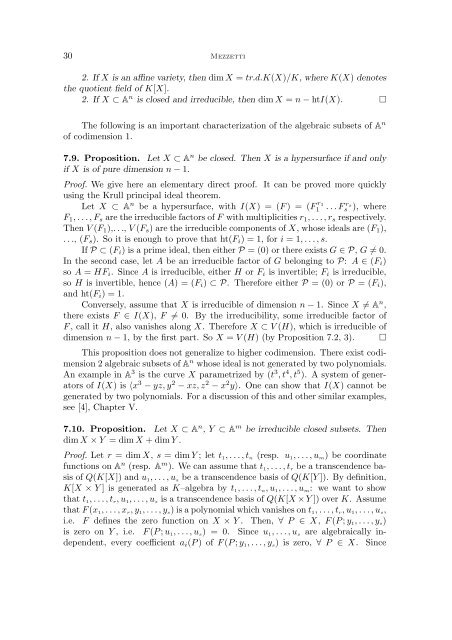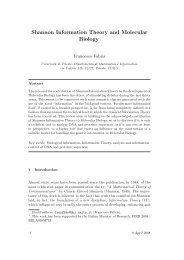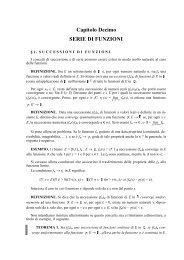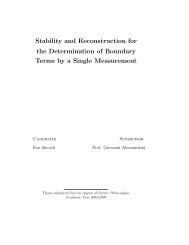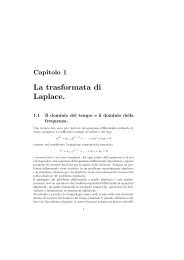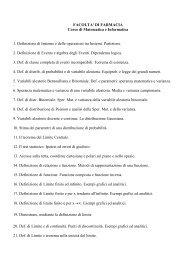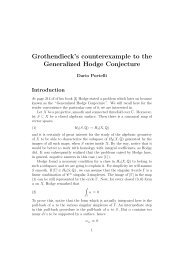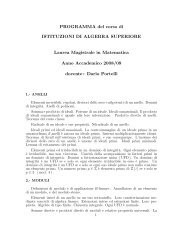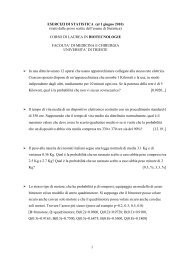INTRODUCTION TO ALGEBRAIC GEOMETRY Note del corso di ...
INTRODUCTION TO ALGEBRAIC GEOMETRY Note del corso di ...
INTRODUCTION TO ALGEBRAIC GEOMETRY Note del corso di ...
Create successful ePaper yourself
Turn your PDF publications into a flip-book with our unique Google optimized e-Paper software.
30 Mezzetti2. If X is an affine variety, then <strong>di</strong>m X = tr.d.K(X)/K, where K(X) denotesthe quotient field of K[X].2. If X ⊂ A n is closed and irreducible, then <strong>di</strong>m X = n − htI(X). □The following is an important characterization of the algebraic subsets of A nof co<strong>di</strong>mension 1.7.9. Proposition. Let X ⊂ A n be closed. Then X is a hypersurface if and onlyif X is of pure <strong>di</strong>mension n − 1.Proof. We give here an elementary <strong>di</strong>rect proof. It can be proved more quicklyusing the Krull principal ideal theorem.Let X ⊂ A n be a hypersurface, with I(X) = (F) = (F r 11 . . .Fr ss ), whereF 1 , . . ., F s are the irreducible factors of F with multiplicities r 1 , . . ., r s respectively.Then V (F 1 ),. . ., V (F s ) are the irreducible components of X, whose ideals are (F 1 ),. . ., (F s ). So it is enough to prove that ht(F i ) = 1, for i = 1, . . ., s.If P ⊂ (F i ) is a prime ideal, then either P = (0) or there exists G ∈ P, G ≠ 0.In the second case, let A be an irreducible factor of G belonging to P: A ∈ (F i )so A = HF i . Since A is irreducible, either H or F i is invertible; F i is irreducible,so H is invertible, hence (A) = (F i ) ⊂ P. Therefore either P = (0) or P = (F i ),and ht(F i ) = 1.Conversely, assume that X is irreducible of <strong>di</strong>mension n − 1. Since X ≠ A n ,there exists F ∈ I(X), F ≠ 0. By the irreducibility, some irreducible factor ofF, call it H, also vanishes along X. Therefore X ⊂ V (H), which is irreducible of<strong>di</strong>mension n − 1, by the first part. So X = V (H) (by Proposition 7.2, 3). □This proposition does not generalize to higher co<strong>di</strong>mension. There exist co<strong>di</strong>mension2 algebraic subsets of A n whose ideal is not generated by two polynomials.An example in A 3 is the curve X parametrized by (t 3 , t 4 , t 5 ). A system of generatorsof I(X) is 〈x 3 − yz, y 2 − xz, z 2 − x 2 y〉. One can show that I(X) cannot begenerated by two polynomials. For a <strong>di</strong>scussion of this and other similar examples,see [4], Chapter V.7.10. Proposition. Let X ⊂ A n , Y ⊂ A m be irreducible closed subsets. Then<strong>di</strong>m X × Y = <strong>di</strong>m X + <strong>di</strong>mY .Proof. Let r = <strong>di</strong>m X, s = <strong>di</strong>m Y ; let t 1 , . . ., t n (resp. u 1 , . . ., u m ) be coor<strong>di</strong>natefunctions on A n (resp. A m ). We can assume that t 1 , . . ., t r be a transcendence basisof Q(K[X]) and u 1 , . . ., u s be a transcendence basis of Q(K[Y ]). By definition,K[X × Y ] is generated as K–algebra by t 1 , . . ., t n , u 1 , . . ., u m : we want to showthat t 1 , . . ., t r , u 1 , . . ., u s is a transcendence basis of Q(K[X ×Y ]) over K. Assumethat F(x 1 , . . ., x r , y 1 , . . ., y s ) is a polynomial which vanishes on t 1 , . . ., t r , u 1 , . . ., u s ,i.e. F defines the zero function on X × Y . Then, ∀ P ∈ X, F(P; y 1 , . . ., y s )is zero on Y , i.e. F(P; u 1 , . . ., u s ) = 0. Since u 1 , . . ., u s are algebraically independent,every coefficient a i (P) of F(P; y 1 , . . ., y s ) is zero, ∀ P ∈ X. Since


